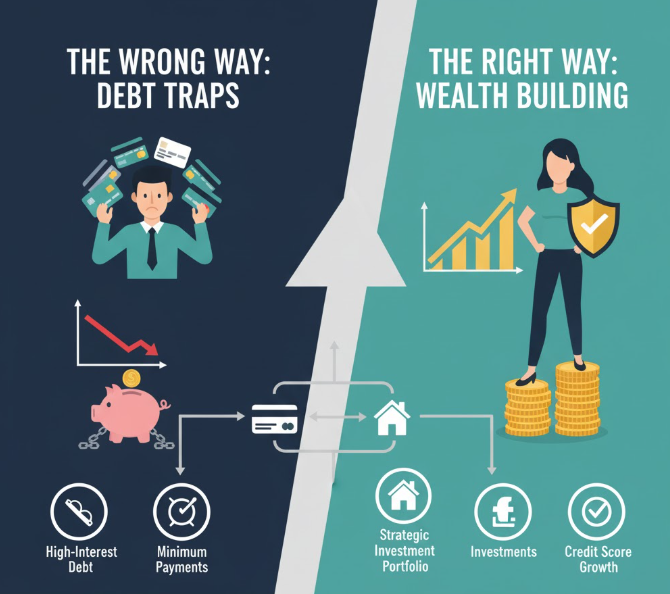Turning Borrowed Money into a Powerful Wealth-Building Tool
Credit can either be your greatest financial ally or your biggest enemy—it all depends on how you use it. Many people view credit as something to avoid, associating it only with debt and financial stress. However, when used strategically, credit can open doors to investment opportunities, help you buy appreciating assets, and ultimately build lasting wealth.
This article breaks down how to use credit wisely, manage it effectively, and transform it into a long-term wealth-building engine—all in simple, practical steps you can start applying today.
What Credit Really Means
At its core, credit is trust. It’s a promise that you’ll pay back borrowed money in the future—usually with some interest. Lenders (like banks or credit card companies) give you access to funds based on your creditworthiness, which is measured through your credit score.
Your credit score acts as a snapshot of your financial reliability. It affects your ability to get loans, the interest rates you’re offered, and even whether you qualify for certain jobs or apartments.
| Credit Score Range | Rating | Meaning |
|---|---|---|
| 800 – 850 | Excellent | Best rates and approvals |
| 740 – 799 | Very Good | Great access to credit |
| 670 – 739 | Good | Generally approved with fair rates |
| 580 – 669 | Fair | Higher rates, limited approval |
| Below 580 | Poor | Risky borrower; hard to get credit |
A high credit score gives you leverage, flexibility, and confidence—three key ingredients for building wealth.
Why Credit is a Wealth-Building Tool
When used wisely, credit helps you:
-
Access Capital for Investment: You can buy assets like property or start a business using borrowed money that appreciates in value.
-
Increase Financial Leverage: Leverage means using other people’s money to grow your own. Smart credit use allows you to multiply your earning potential.
-
Create Positive Financial History: Responsible credit use builds trust with lenders, leading to better opportunities and lower interest rates.
-
Protect Cash Flow: Instead of spending all your savings at once, you can finance large purchases and preserve cash for emergencies or investments.
Let’s explore how to do this the right way.
1. Build a Solid Foundation: Establishing Good Credit
Before you can use credit to build wealth, you need to build good credit habits. Think of it like laying the foundation before building a house.
Start Small and Build Consistency
-
Apply for a secured credit card if you’re just starting. It’s backed by your own deposit, making it safe and easy to manage.
-
Use it for small, regular purchases—like gas or groceries—and pay off the balance in full each month.
-
This shows lenders you’re responsible and disciplined.
Pay On Time—Every Time
Payment history makes up 35% of your credit score, the single largest factor. Even one late payment can hurt your score significantly.
Pro tip: Set up automatic payments or reminders to never miss due dates.
Keep Balances Low
Credit utilization—how much of your available credit you use—should stay below 30%.
For example:
If your limit is $1,000, aim to use no more than $300 before paying it off.
Avoid Too Many Applications
Every credit inquiry slightly lowers your score. Apply for new credit only when necessary.
2. Smart Borrowing: Using Credit Strategically
Borrowing isn’t bad—it’s how and why you borrow that matters.
Use Credit for Asset-Building, Not Lifestyle Inflation
Good debt helps you buy things that increase in value or generate income, like:
-
Real estate
-
Education or certifications that increase your earning potential
-
Starting or expanding a business
Avoid using credit for short-lived pleasures like:
-
Luxury gadgets
-
Vacations you can’t afford
-
Impulse shopping
Good Debt vs. Bad Debt
| Type of Debt | Example | Impact on Wealth |
|---|---|---|
| Good Debt | Home mortgage, business loan, student loan | Builds equity, improves income potential |
| Bad Debt | High-interest credit cards, payday loans | Drains income, limits financial growth |
3. The Power of Credit Cards—Used Wisely
Credit cards are often blamed for debt, but when handled wisely, they can be a powerful financial tool.
Benefits of Responsible Credit Card Use
-
Build Credit Fast: Every on-time payment improves your score.
-
Earn Rewards: Many cards offer cashback or points on purchases.
-
Emergency Cushion: Access to funds when unexpected expenses arise.
-
Purchase Protection: Credit cards often come with fraud and theft insurance.
Smart Credit Card Practices
-
Pay in Full Every Month: Avoid paying interest.
-
Use Rewards Strategically: Apply cashback or miles to necessary expenses.
-
Monitor Statements: Check for unauthorized charges or errors.
-
Increase Credit Limit Over Time: It lowers your utilization ratio and boosts your score.
4. Leverage Credit to Acquire Wealth-Building Assets
Once your credit is strong, it becomes a launchpad for investment.
Real Estate
-
Use mortgage financing to buy property.
-
Rent it out to generate passive income.
-
Over time, the property value increases, and your wealth grows through equity.
Example:
If you buy a $200,000 property with a $20,000 down payment, you control a valuable asset worth 10 times your investment.
That’s financial leverage in action.
Business Financing
-
A business loan or line of credit can fund startup costs or expansion.
-
Use profits to pay back the loan and grow your business further.
Stock Market Investing
Some investors use low-interest personal loans to invest in high-yield assets, though this requires strong discipline and risk management.
5. Keep Your Debt-to-Income Ratio in Check
Your Debt-to-Income (DTI) ratio measures how much of your monthly income goes toward paying debts. Lenders use it to evaluate your borrowing capacity.
| DTI Ratio | Category | Interpretation |
|---|---|---|
| Below 30% | Excellent | Plenty of room for future credit |
| 30% – 40% | Good | Manageable but monitor closely |
| 40% – 50% | Fair | Risk of overextension |
| Above 50% | Poor | Too much debt relative to income |
Keep your DTI low to maintain financial flexibility and borrowing power.
6. Manage Interest Rates Like a Pro
Interest rates determine how much your borrowed money actually costs you. The higher the rate, the harder it becomes to build wealth.
Tips to Lower Interest Costs
-
Refinance loans when rates drop.
-
Transfer balances to lower-rate cards if possible.
-
Pay more than the minimum—even small extra payments save big over time.
-
Negotiate with lenders; a good payment history can earn you better terms.
Example:
If you owe $5,000 at 18% interest and only make minimum payments, it could take over 10 years to pay off!
By doubling payments, you could finish in less than 3 years and save thousands.
7. Diversify Your Credit Mix
Having different types of credit accounts improves your financial profile.
Lenders like to see that you can handle various kinds of credit responsibly.
Examples of a Healthy Credit Mix:
-
Credit card (revolving credit)
-
Car loan (installment loan)
-
Student loan or mortgage
-
Small business credit line
A balanced mix makes your profile stronger and more trustworthy.
8. Protect Your Credit Health
Building wealth through credit requires long-term maintenance.
Monitor Regularly
-
Use free credit report sites to track your score.
-
Check for errors or suspicious activity that could lower your rating.
Dispute Inaccuracies
If you find an error, contact the credit bureau immediately to correct it. A small mistake could cost you thousands in higher interest.
Avoid Closing Old Accounts
Older accounts increase your credit history length, which boosts your score.
If a card has no annual fee, keep it open even if you rarely use it.
9. Plan for Emergencies Without Destroying Credit
Emergencies are part of life, but they don’t have to wreck your financial plan.
Build an Emergency Fund
-
Save at least 3–6 months’ worth of living expenses.
-
Keep it in a high-yield savings account for easy access.
When emergencies strike, use your emergency fund first, not your credit card.
Use Credit as Backup Only
If you must use credit in a crisis:
-
Borrow with a repayment plan in mind.
-
Avoid cash advances—they carry the highest interest rates.
10. Turn Good Credit into Long-Term Wealth
Once your credit is strong, you can use it to scale wealth-building strategies.
Invest in Real Assets
-
Real estate, vehicles for business, or even solar panels can produce long-term returns.
Leverage Business Credit
-
Use business credit instead of personal credit for growth—this protects your personal score and assets.
Access Better Financial Products
-
Premium credit cards offer travel perks, insurance, and zero-interest introductory periods.
-
High credit scores qualify you for lower mortgage rates, saving tens of thousands over time.
Sample Strategy: Using Credit to Build Wealth Step-by-Step
| Step | Action | Outcome |
|---|---|---|
| 1 | Open a secured credit card | Start building credit history |
| 2 | Keep utilization below 30% | Maintain healthy score |
| 3 | Pay off balances monthly | Avoid interest, build trust |
| 4 | Take a small personal loan | Diversify credit mix |
| 5 | Apply for mortgage/business credit | Invest in appreciating assets |
| 6 | Reinvest profits from assets | Grow wealth over time |
11. Common Mistakes to Avoid
Even financially smart people can make credit missteps. Avoid these traps:
-
Paying Only the Minimum: You’ll pay more in interest and stay in debt longer.
-
Using Credit for Wants: Focus on needs or assets that generate income.
-
Ignoring Credit Reports: Errors or identity theft can quietly ruin your score.
-
Too Many Loans at Once: Lenders may view you as a risk.
-
Closing Credit Accounts After Paying Them Off: This shortens your credit history.

How to Use Credit Wisely to Build Long-Term Wealth
12. The Emotional Side of Credit
Money management isn’t just numbers—it’s mindset.
-
Be patient. Wealth building takes time; consistency beats speed.
-
Avoid comparison. Others’ lifestyles may be debt-fueled illusions.
-
Stay disciplined. If you treat credit as a tool, not free money, it will work for you—not against you.
13. Real-Life Example: How Credit Builds Wealth Over Time
Scenario:
Sara, age 25, starts with a secured credit card and builds her score to 760 in two years.
She uses that score to qualify for a low-interest mortgage and buys a duplex. She lives in one unit and rents the other.
After 10 years:
-
Her property appreciates by 40%.
-
Rental income covers her mortgage and creates positive cash flow.
-
Her credit remains excellent, allowing her to buy a second property.
By age 35, Sara has over $200,000 in equity and a stable income stream—all because she used credit strategically and responsibly.
14. Key Takeaways
| Principle | Action Step | Result |
|---|---|---|
| Use credit to buy assets, not liabilities | Invest in appreciating items | Long-term wealth growth |
| Pay on time, every time | Automate payments | Strong credit history |
| Keep utilization low | Use <30% of credit limit | Better credit score |
| Monitor reports | Check quarterly | Prevent errors/fraud |
| Borrow strategically | Focus on ROI | Build income and equity |
Conclusion: Credit as a Path to Financial Freedom
Credit isn’t your enemy—it’s a stepping stone to financial independence when used wisely. It can open doors to property ownership, entrepreneurship, and investment opportunities that accelerate your journey toward wealth.
The key is to stay disciplined, avoid emotional spending, and view credit as a strategic tool—not a shortcut. By maintaining excellent credit habits, you’ll not only protect your financial health but also create the foundation for a prosperous, secure future.
Final Thought
Building wealth through credit isn’t about luck—it’s about strategy, patience, and smart decisions. Every payment you make, every loan you manage, and every asset you acquire moves you closer to financial freedom.
Start today—build your credit, leverage it wisely, and let it work for you instead of against you.

